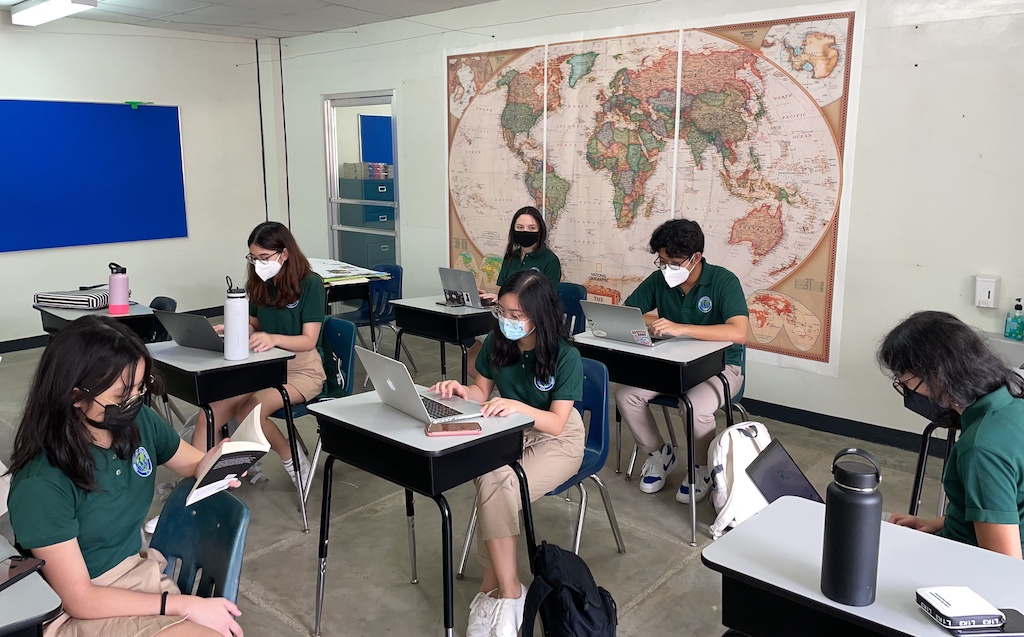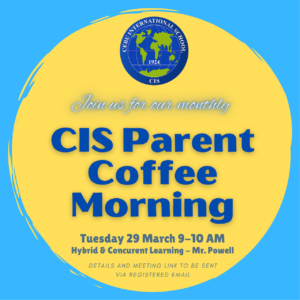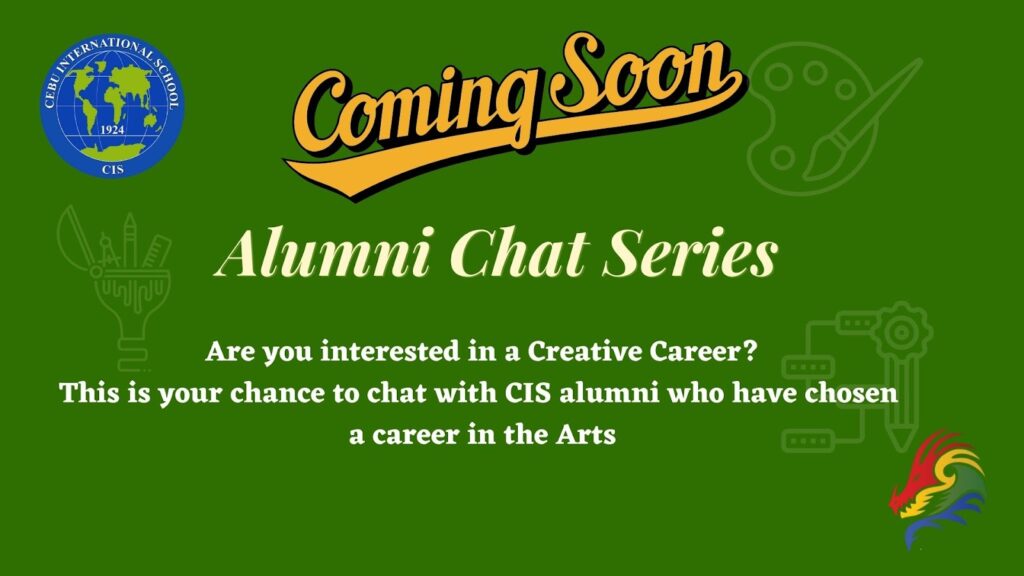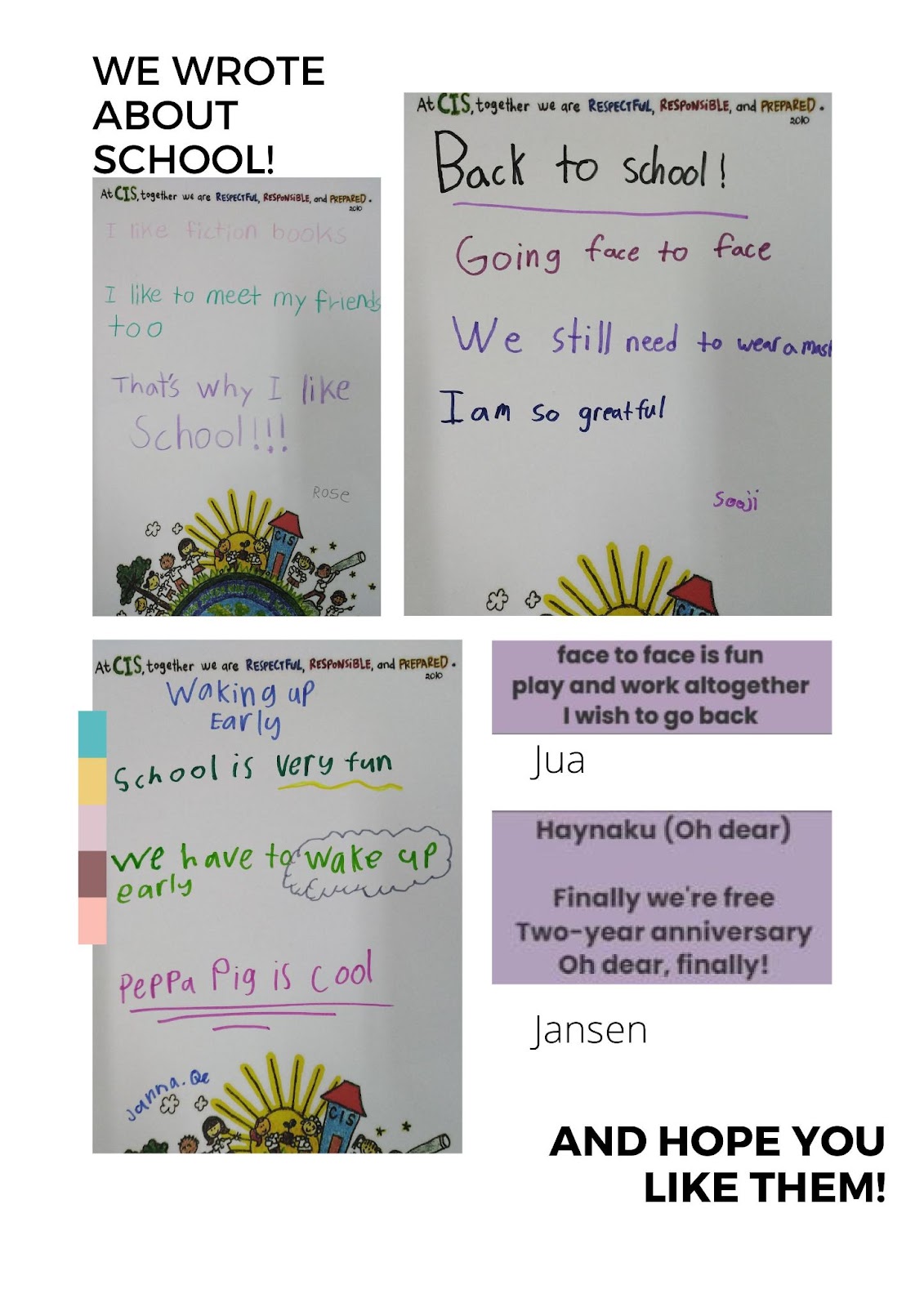
Principal’s Corner
Mr. Andrew Powell, EY – Grade 12 Principal
As we head into the second week of our hybrid learning (blending on-line and face-to-face learning) with concurrent students (having some students in class face-to-face while others join remotely), I thought it appropriate to cover some of the aspects of the ways in which our program is being delivered. These methods were also the focus of our teachers’ professional development sessions this afternoon and continue to be part of our commitment to leading the region in innovative school practices.
 It is fair to say that as educators we are mapping new instructional landscapes. As there is limited formal research on concurrent learning practices in schools, we are looking at the experiences of our colleagues around the world and adapting practices to suit our circumstances. These can vary from grade level to grade level depending upon the developmental level of our students, number of students present on campus and the nature of the desired learning outcomes. The quality of our educators at CIS also means that we have teachers that are truly leading the way with the nature of their practice.
It is fair to say that as educators we are mapping new instructional landscapes. As there is limited formal research on concurrent learning practices in schools, we are looking at the experiences of our colleagues around the world and adapting practices to suit our circumstances. These can vary from grade level to grade level depending upon the developmental level of our students, number of students present on campus and the nature of the desired learning outcomes. The quality of our educators at CIS also means that we have teachers that are truly leading the way with the nature of their practice.
The opportunity for students to (re)-connect with each other has certainly been a highlight for those students that have been able to be on campus. It has been wonderful to watch students socialize with each other, work collaboratively in group situations and in the case of our younger students, explore the campus and have fun with physical and creative play. For many of our newer students, it is their first opportunity to sit down with their peers and get to know one another without a computer screen. I know that many of our parents have also appreciated the opportunity to meet each other and have a little time to themselves during the day.

While it’s wonderful to celebrate “life on campus” our teachers are also encouraged to be mindful of those working from home and ways in which they can ensure equity of access to the hybrid experience. The need for routines that incorporate welcoming our students are critical to relationship-building and relationship-maintenance. These instances are often built into the beginning of class while purposefully concluding activities, and student feedback at the end of classes helps teachers to understand what is working and what can be modified. Students, whether situated at home or on campus are entitled to individual help from their teachers and we want our community of learners to take advantage of this.
We have known for a long time that traditional, teacher-led whole class instruction is not the most effective way to engage our students day after day. This is even more so during concurrent learning. As I have walked through various classrooms over the past week, I have seen some innovative approaches. These have included but are certainly not limited to:

Station-rotation: in which the teacher organizes a series of learning engagements (stations) for students to rotate through. These will include a teacher-led station as well as individual or small group activities for students that are both on campus and online. In the elementary school there will often be an additional teacher present at stations to support student learning.
Two station rotation: A modified version of the station-rotation, the teacher begins with a welcoming activity and sets expectations for the class before working intensely with one group of students while the others work in groups or independently before switching so that the teacher may support the remaining students.
Flipped classroom: This model was already being employed by several teachers before the pandemic and involves providing students with short lectures or explanations prior to class so that during synchronous class times the teacher can work on answering questions, work through problems while being provided with real-time feedback or have students work in small groups to apply knowledge to various scenarios.
Menu model: This approach involves teachers providing students with learning engagements that they may complete at their own pace. It allows a high degree of differentiation as well as student choice, which increases engagement. It also enables the teacher to individually monitor and meet with students to provide explicit feedback and shape further task engagement.
In highlighting some of the approaches that we are taking at CIS to support our students’ concurrent learning on and off campus, I’d like to draw on the thoughts of one of our current seniors.
“School is an experience; it’s about creating connections that last a lifetime. It’s about making friends. It’s also about meeting different kinds of people and adjusting the way in which you work with them. School is our first step towards adapting to the world and sets up a foundation for life.”
I’m glad that we have the opportunity to be back on campus and trust that our efforts will be appreciated and help our students to be well placed to contribute to a better world.

Grade 4 Class
by Mr. Sten Coppin, Grade 4 Teacher
Grade 4 decided to celebrate the transition to face-to-face learning by learning about haiku poetry and writing our own poems. Haiku poems have a strict code to follow, they are always 3 lines of 5, 7, and 5 syllables. These poems do not have rhymes and sometimes have a surprising or funny last line. Our students who are still learning remotely also contributed, writing about how school is going in general for them. Now it’s time for you to brush up your knowledge about syllables and enjoy our grade 4 writer’s hand-written poetry, enjoy!
DP Art Exhibition
by Mr. Jessie Saclo, DP Art Teacher
The Exhibition is the internal assessment component of the Diploma Programme Visual Arts course which students at SL and HL complete by the end of their senior year. Students submit for assessment a selection of resolved artworks that show evidence of their technical accomplishment. The selected pieces demonstrate the exploration, experimentation, and application of materials, ideas, and practices that students utilized to realize and communicate their artistic intentions.
During the Exhibition, students showcase the skills, techniques, and art styles they have explored and developed to produce independent work through a variety of media and art-making forms. Each resolved artwork is supported by an exhibition text which is a brief outline of the work’s original intentions, and any reference sources that have influenced the individual piece. In addition to the exhibition text, students draft a curatorial rationale, a written description of why specific artworks have been chosen and presented in a particular format. It further explains the challenges, influences, triumphs, innovations, issues that have impacted the selection and presentation of the artworks, and the context of how the body of work presented connects and communicates with the viewer.
College/Careers Counselor Corner
by Ms. Jenny Basa, College/Careers Counselor

Upcoming Virtual Events and FAIRS: (students & parents are welcome)
March 26
1:00 – 7:00 PM
LINK to register
Study Abroad Virtual Fair

March 26
10:00AM
LINK to register
Co-op Programs in Canada
One of the best ways to gain hands-on experience is through work-integrated learning opportunities. In Canada, these opportunities are also known as co-operative education.

The co-op program provides students with the opportunity to apply the skills and knowledge they’ve learned in the classroom through a program-related work experience. Students who take co-op have an edge when they graduate and go out into the workforce.
March 29
Tuesday
6:00PM PHT
Link to register
Scholarship Opportunities in Canada: Studying abroad can be an expensive undertaking. Hence, schools in Canada offer scholarships to international students in order to attract more students.
If you are interested in learning more about Scholarship Opportunities for international students in Canada, we invite you to attend this webinar.

SAT Update
To register for the SAT, you may click on this link. If you need assistance or have any questions, please feel free to email Ms. Jenny Basa at jbasa@cis.edu.ph.
|
2021-2022 TEST DATES |
Registration Deadline |
|
May 7, 2022 |
April 8, 2022 |
The Optional SAT Essay and Subject Tests have been discontinued.
IT Reminders







